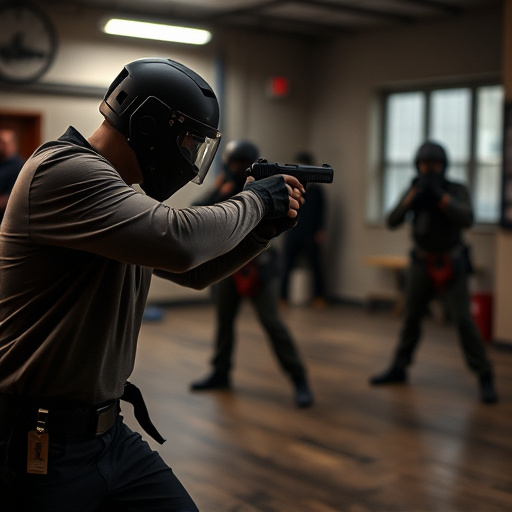Non-lethal self-defense weapons like tasers and stun guns offer seniors safe protection options with reduced mobility. Tasers provide longer reach, while stun guns deliver close-range shocks for temporary incapacitation. Responsible training is crucial for effectiveness and safety in using these tools tailored to senior needs.
In today’s world, understanding non-lethal self-defense weapons is crucial for personal safety, especially for seniors seeking protection. This article delves into the key differences between Tasers and stun guns—two popular options in the market. We explore their unique features, functionalities, and effectiveness, offering insights to help seniors make informed choices. Discover which tool best suits your needs based on design, range, and safety considerations, ensuring peace of mind while prioritizing non-lethal self-defense strategies.
- Understanding Non-lethal Self-Defense Weapons
- Taser: Features and Functionality
- Stun Gun: Design and Effectiveness
- Choosing the Right Tool for Seniors' Safety
Understanding Non-lethal Self-Defense Weapons
Non-lethal self-defense weapons, such as tasers and stun guns, offer a crucial option for seniors looking to protect themselves. Unlike traditional firearms, these devices are designed to incapacitate an attacker temporarily without causing permanent harm or death. For older adults who may have reduced mobility or strength, non-lethal force can provide peace of mind and a critical tool in potentially dangerous situations.
When considering non-lethal self-defense weapons for seniors, it’s essential to understand the differences between tasers and stun guns. Tasers fire small probes that deliver an electrical shock, rendering the target immobile for several minutes. Stun guns, on the other hand, emit a powerful electric discharge that causes intense pain but may not always result in complete incapacitation. Both options require proper training and responsible handling to ensure their effectiveness and safety.
Taser: Features and Functionality
Tasers, officially known as Conducted Electrical Weapons (CEWs), are non-lethal self-defense tools designed to incapacitate individuals through a powerful electrical pulse. These devices fire two thin probes connected to wires, delivering a high-voltage, low-current electric shock that disrupts muscle control, causing temporary immobilization. The primary function of a taser is to subdue an assailant without causing serious harm, making it a popular choice for law enforcement and self-defense enthusiasts alike, especially those seeking non-lethal options for seniors looking to protect themselves.
Tasers offer several features that set them apart from traditional stun guns. They are typically more accurate due to their ability to shoot probes from a distance, allowing users to disable attackers without close physical contact. Additionally, tasers often have safety features like trigger locks and adjustable voltage settings, providing control over the level of force used. Their non-lethal nature makes them ideal for situations where a quick incapacitation is needed while minimizing the risk of permanent injury or death.
Stun Gun: Design and Effectiveness
Stun guns, often used as non-lethal self-defense weapons, are designed to incapacitate an assailant through electrical shock rather than physical force. These devices typically consist of a grip with two metal probes at the end, which make contact with the target to deliver a powerful electric current. The current disrupts muscle control, causing temporary paralysis and disorientation in the attacker.
While stun guns are popular among individuals seeking non-lethal options for self-defense, especially for seniors looking for ways to protect themselves without resorting to lethal force, their effectiveness can vary. Factors such as proper training, distance, and the model of the stun gun play significant roles in ensuring its success. Despite claims, stun guns may not always be as reliable as some users hope, particularly in stressful situations where muscle control and reaction time are crucial for safety.
Choosing the Right Tool for Seniors' Safety
For seniors looking to enhance their personal safety, selecting the appropriate non-lethal self-defense weapon is a crucial decision. When considering options like Tasers or stun guns, understanding the nuances between them becomes essential. One key difference lies in their effectiveness and range; Tasers typically have a longer reach, making them more suitable for creating distance from potential threats while stun guns provide a closer-range electric discharge to immobilize an attacker temporarily.
Seniors should prioritize tools that offer both safety and ease of use, especially considering physical limitations or reduced strength. Stun guns often come with simpler designs, allowing for quicker deployment during emergencies. Additionally, many modern models include features like bright flashlights and loud alarms, serving as effective deterrents. Ultimately, the choice depends on individual needs, comfort levels, and the level of protection sought.
When it comes to ensuring seniors’ safety, understanding the nuances between non-lethal self-defense weapons like tasers and stun guns is paramount. Both offer effective deterrents against potential threats, but each has unique features. Tasers excel in delivering powerful jolts from a distance, while stun guns provide close-range electric shocks. For seniors considering these options, choosing the right tool depends on individual needs, comfort levels, and situations they may encounter. Opting for the best fit among non-lethal weapons can empower them to maintain independence and safety in their daily lives.
